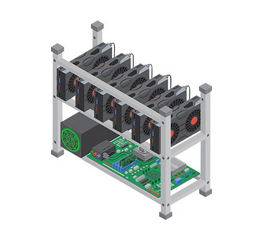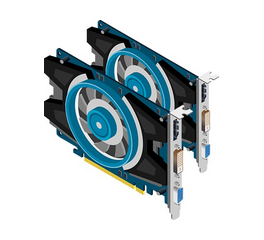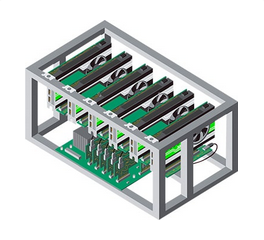Description
Bitcoin Investment Trends
Bitcoin Investment Trends. GPU mining, or graphics processing unit mining, plays a pivotal role in the cryptocurrency ecosystem. This method involves using the powerful computational capabilities of GPUs to solve complex mathematical problems, which are integral to validating transactions on blockchain networks. The rise of digital currencies, such as Bitcoin and Ethereum, has significantly amplified the demand for efficient and cost-effective mining solutions.
The Radeon RX 470 has emerged as a popular choice among miners due to its balance of performance and affordability. This GPU offers substantial hashing power, which is essential for mining operations, while maintaining an energy-efficient profile. Miners are drawn to the Radeon RX 470 because it provides a reliable and scalable solution for both beginners and seasoned professionals. Bitcoin Investment Trends
A key aspect that makes GPU mining attractive is its flexibility. Unlike ASIC miners, which are designed for specific algorithms, GPUs can be repurposed for various types of mining or even other computational tasks when not mining. This versatility ensures that miners can adapt to market changes and optimize their operations across different cryptocurrencies. Bitcoin Investment Trends
Furthermore, the efficiency of GPU mining, particularly with the Radeon RX 470, cannot be overstated. Efficiency in this context refers not only to the power consumption relative to the hashing power but also to the overall cost-effectiveness. The Radeon RX 470 manages to strike an impressive balance, offering high performance without the exorbitant energy costs associated with more powerful GPUs. This makes it an attractive option for miners looking to maximize their profits while minimizing overheads.
In summary, GPU mining remains a crucial component of the cryptocurrency mining landscape due to its flexibility and efficiency. The Radeon RX 470 stands out in this domain, offering a compelling mix of performance, cost-effectiveness, and energy efficiency, making it a preferred choice for many in the mining community.
Overview of the Radeon RX 470 Bitcoin Investment Trends
The Radeon RX 470 is a mid-range graphics processing unit (GPU) from AMD, renowned for its balance between performance and efficiency, making it a popular choice for cryptocurrency mining. Launched in 2016 as part of the Polaris architecture, the RX 470 leverages 14nm FinFET technology to deliver impressive computational power while maintaining reasonable power consumption levels.
One of the key specifications of the Radeon RX 470 is its memory configuration. It is equipped with either 4GB or 8GB of GDDR5 memory, which operates at an effective memory clock speed of 6600 MHz. This ample memory capacity, combined with a 256-bit memory interface, ensures smooth handling of large datasets and complex calculations, essential for efficient mining operations.
The core clock speeds of the RX 470 further underscore its mining capabilities. The base clock speed is 926 MHz, which can boost up to 1206 MHz under load. This dynamic clocking ability allows the GPU to adapt to varying computational demands, optimizing performance without unnecessary power draw. The Radeon RX 470 features 2048 stream processors, which facilitate parallel processing and enhance the overall efficiency of mining tasks.
Power consumption is a critical factor in mining, and the RX 470 excels in this area. With a typical board power of 120W, it strikes a balance between energy efficiency and performance. This makes it an attractive option for miners who seek to maximize their return on investment by minimizing electricity costs while maintaining robust performance. Bitcoin Investment Trends
In terms of architecture, the Polaris design enhances the RX 470’s computational efficiency and thermal management. This architecture includes advanced features like asynchronous compute, which improves the handling of complex workloads, and AMD’s PowerTune technology, which dynamically adjusts power usage to optimize performance and efficiency. Bitcoin Investment Trends
Overall, the Radeon RX 470 stands out in the market for its blend of memory capacity, clock speed, and power efficiency. These features make it a formidable option for mining enthusiasts looking to achieve high performance with manageable power consumption. Bitcoin Investment Trends
Setting Up Your Radeon RX 470 for Mining Bitcoin Investment Trends
To begin mining with the Radeon RX 470, it is crucial to follow a structured setup process to ensure optimal performance and efficiency. The initial step involves installing the necessary drivers. Ensure that you download the latest drivers from the official AMD website to keep your GPU running smoothly. AMD’s Radeon Software Adrenalin Edition is a recommended option, as it provides regular updates and optimizations specifically tailored for mining.
Next, configuring the BIOS settings of your Radeon RX 470 is essential. Modifying the BIOS can significantly improve the mining performance of your GPU. Tools such as Polaris BIOS Editor are commonly used to tweak memory timings, voltage, and core clock speeds. These modifications should be done carefully, as incorrect settings can lead to instability or hardware damage. It is advisable to back up the original BIOS before making any changes.
Optimizing the GPU settings is the final step in setting up your Radeon RX 470 for mining. Software like MSI Afterburner can be utilized to adjust core clock speeds, memory clock speeds, and power limits. Lowering the core clock and increasing the memory clock can help improve mining efficiency by reducing power consumption while maintaining high hash rates. Additionally, setting an appropriate fan speed curve will help manage the GPU temperature, preventing overheating during extended mining sessions.
Several tools and software can further enhance your mining setup. For instance, Claymore’s Dual Miner is popular for its dual mining capabilities, allowing users to mine Ethereum and a secondary coin simultaneously. Furthermore, monitoring tools like GPU-Z and HWMonitor can provide real-time data on GPU performance, helping you make informed adjustments. Bitcoin Investment Trends
By meticulously following these steps and utilizing the recommended tools, you can effectively set up your Radeon RX 470 for mining, ensuring maximum efficiency and profitability in your mining endeavors.
Mining Software Compatible with Radeon RX 470
The Radeon RX 470 has established itself as a reliable GPU for cryptocurrency mining. To maximize its efficiency, selecting the right mining software is crucial. Several options are compatible with the Radeon RX 470, each offering unique features and benefits. Here, we will explore some popular choices, including Claymore, PhoenixMiner, and Ethminer, providing insights into their pros and cons.
Claymore
Claymore is a well-known mining software that supports various cryptocurrencies, making it a versatile option for miners using the Radeon RX 470. One of its standout features is the dual mining capability, allowing users to mine two different coins simultaneously, effectively doubling the potential revenue. Claymore also offers an easy-to-use interface and regular updates, ensuring compatibility with the latest mining algorithms. However, it does have a developer fee of 1%, which some users might find disadvantageous. Additionally, while the software is robust, it may require some tweaking to optimize performance fully. Bitcoin Investment Trends
PhoenixMiner
PhoenixMiner is another popular choice among miners. It is praised for its high performance and low dev fee of 0.65%, making it an attractive option for those seeking cost-efficiency. PhoenixMiner is optimized for Ethereum mining but supports other coins as well. It boasts a user-friendly interface and extensive configuration options, enabling miners to fine-tune settings for maximum efficiency. However, the complexity of these options can be daunting for beginners. Furthermore, while PhoenixMiner generally provides stable performance, some users have reported occasional crashes or bugs.
Ethminer Bitcoin Investment Trends
Ethminer is an open-source mining software that is highly regarded within the mining community. It is specifically designed for Ethereum mining and offers a high level of customization, appealing to advanced users who wish to optimize their mining rigs. Ethminer does not charge a developer fee, making it a cost-effective solution for miners using the Radeon RX 470. Despite its advantages, Ethminer can be challenging for novices due to its command-line interface. Additionally, being open-source, it may not receive updates as frequently as other mining software, potentially affecting compatibility with newer algorithms.
In conclusion, choosing the right mining software for the Radeon RX 470 depends on your specific needs and level of expertise. Claymore offers versatility and dual mining capabilities, PhoenixMiner provides high performance with a low dev fee, and Ethminer delivers cost-effectiveness and customization. Each option has its strengths and weaknesses, so it is essential to consider these factors when making your decision.
Optimizing Performance and Efficiency
Maximizing the performance and efficiency of the Radeon RX 470 in a mining setup requires a multi-faceted approach. Foremost among these strategies is overclocking. By adjusting the GPU and memory clocks, miners can enhance the overall hash rate. However, it is crucial to proceed cautiously. Incremental adjustments, followed by rigorous stability testing, ensure that the system remains reliable under prolonged loads. Utilizing tools such as MSI Afterburner or Radeon WattMan can facilitate this process, providing user-friendly interfaces for precise tuning.
Equally important is managing power consumption. Mining operations can be energy-intensive, making it essential to strike a balance between performance and energy usage. Power limits can be adjusted within overclocking tools, allowing miners to find a sweet spot where the Radeon RX 470 operates efficiently without excessive power draw. Lowering the voltage while maintaining stable performance can significantly reduce electricity costs, thus improving overall profitability. Bitcoin Investment Trends
Temperature management is another critical factor. High temperatures can lead to hardware degradation and reduced efficiency. Ensuring proper airflow within the mining rig is imperative. This can be achieved by arranging GPUs to prevent heat buildup, using high-quality thermal paste, and incorporating additional cooling solutions such as case fans or liquid cooling systems. Monitoring software like HWMonitor or GPU-Z can provide real-time temperature readings, allowing for proactive adjustments.
Balancing performance with energy efficiency is paramount. By continuously monitoring and tweaking settings, miners can optimize their setups to achieve the best possible return on investment. It’s also advisable to stay informed about the latest driver updates and mining software versions, as these can offer performance improvements and bug fixes that enhance the Radeon RX 470’s efficiency.
In essence, optimizing the Radeon RX 470 for mining involves a delicate dance of overclocking, power management, and temperature control. By taking a holistic approach and paying attention to detail, miners can maximize both performance and profitability.
Common Issues and Troubleshooting
Operating the Radeon RX 470 for mining can present a series of challenges that may affect efficiency and overall performance. Understanding common issues and knowing how to address them is crucial for maintaining optimal functionality. Below, we outline some prevalent problems and provide actionable solutions to keep your mining operations running smoothly.
Driver Conflicts: One of the most frequent issues miners face is driver conflicts. The Radeon RX 470 requires up-to-date drivers to operate efficiently. If you encounter problems, ensure that you have installed the latest drivers from AMD’s official website. Sometimes, older driver versions might be more stable for mining, so experimenting with different versions can be beneficial. Uninstalling and performing a clean installation of drivers often resolves many software-related conflicts.
Overheating Problems: Overheating can significantly impair the performance of your Radeon RX 470 and may lead to hardware damage. To mitigate overheating, ensure your mining rig is well-ventilated. Regularly clean dust from the GPU and consider using additional cooling solutions such as aftermarket fans or liquid cooling systems. Monitoring tools like MSI Afterburner can help you keep track of temperature and adjust fan speeds accordingly.
Connectivity Issues: Connectivity problems can disrupt mining operations. If your Radeon RX 470 isn’t being detected by your system, check the PCIe slot and power connections. Ensure that the GPU is properly seated in the slot and that all power connectors are securely attached. Sometimes, updating the motherboard BIOS or changing the PCIe settings in the BIOS can resolve detection issues.
For miners seeking further assistance, numerous online forums and communities are dedicated to mining with the Radeon RX 470. Platforms like Reddit, Bitcointalk, and dedicated Discord channels can offer valuable insights and solutions from experienced miners. Additionally, consulting the official AMD support can provide more structured guidance and troubleshooting tips.
Comparing Radeon RX 470 to Other Mining GPUs
When it comes to maximizing mining efficiency, the Radeon RX 470 stands out as a compelling option. However, it is essential to compare it to other popular mining GPUs, such as the Nvidia GTX 1060 and the Radeon RX 580, to determine its relative advantages and disadvantages.
The Radeon RX 470 is known for its excellent balance between cost and performance. It offers a hash rate of approximately 24-25 MH/s for Ethereum mining, making it a competitive choice for miners who are looking for a cost-effective solution. In terms of power consumption, the RX 470 operates at around 120 watts, which is relatively moderate and helps in maintaining a lower electricity cost.
On the other hand, the Nvidia GTX 1060 is another popular choice among miners. This GPU delivers a hash rate of around 20-22 MH/s for Ethereum, which is slightly lower than the RX 470. However, the GTX 1060 is praised for its superior energy efficiency, consuming about 90 watts. This lower power consumption can lead to significant savings on electricity bills over time, making it an attractive option for those prioritizing energy efficiency.
The Radeon RX 580, in contrast, offers a higher hash rate, reaching up to 29-30 MH/s for Ethereum mining. This makes it a powerful contender in terms of raw mining performance. However, it comes at a higher power consumption of approximately 185 watts, which can increase operational costs due to higher electricity usage. Additionally, the RX 580 is often priced higher than the RX 470, which could be a deciding factor for budget-conscious miners.
In conclusion, each GPU has its strengths and weaknesses. The Radeon RX 470 offers a balanced approach with decent performance and moderate power consumption, making it a well-rounded choice. The Nvidia GTX 1060 excels in energy efficiency, while the Radeon RX 580 provides higher performance at the cost of increased power usage. Miners should consider their specific needs and budget constraints to select the best GPU for their mining operations.
Future Prospects and Upgrades
As we look towards the future of GPU mining, it’s essential to consider the evolving landscape and the role of the Radeon RX 470 within it. The industry is characterized by rapid advancements in technology, which continuously influence the efficiency and profitability of mining operations. While the Radeon RX 470 has proven to be a reliable and cost-effective choice for miners, its continued viability will depend on several factors.
One of the critical aspects to consider is the development of new GPU models with enhanced performance and energy efficiency. Manufacturers are consistently pushing the boundaries, introducing GPUs that offer higher hash rates and lower power consumption. For instance, the latest iterations of AMD’s and NVIDIA’s GPUs are designed to deliver superior mining capabilities, which could potentially overshadow the RX 470’s performance. As these newer models become more accessible and affordable, miners may find it beneficial to upgrade their hardware to maintain competitive advantage.
Another significant trend in the mining industry is the shift towards more sustainable and eco-friendly practices. The increasing emphasis on reducing carbon footprints has led to the development of GPUs that are not only powerful but also energy-efficient. The Radeon RX 470, while efficient, may eventually be outpaced by newer models designed with advanced cooling systems and lower energy requirements. This shift could make newer GPUs a more attractive option for miners focused on sustainability.
Moreover, the introduction of new mining algorithms and blockchain technologies could also impact GPU choices. Emerging algorithms that favor different hardware configurations might render older models like the Radeon RX 470 less effective. Staying informed about these technological advancements is crucial for miners who wish to optimize their operations continually.
In conclusion, while the Radeon RX 470 remains a competent and reliable GPU for mining, its future viability will depend on ongoing technological advancements and industry trends. Miners should stay abreast of new developments and consider potential upgrades to ensure they maximize their mining efficiency and stay competitive in an ever-evolving market.




Reviews
There are no reviews yet.